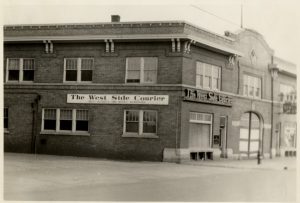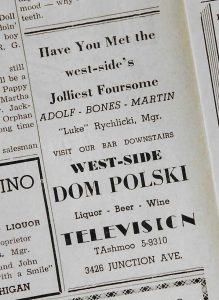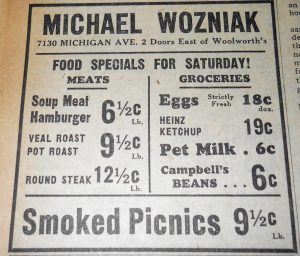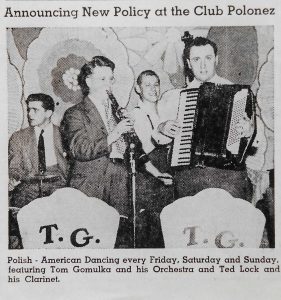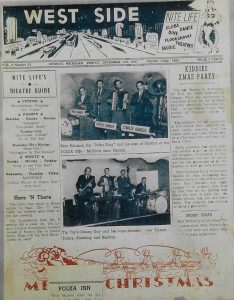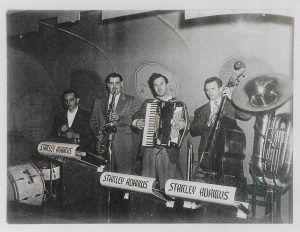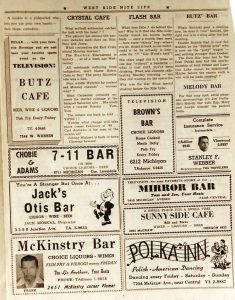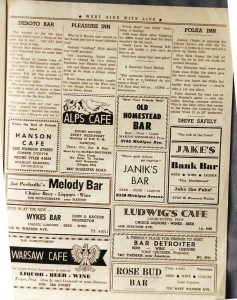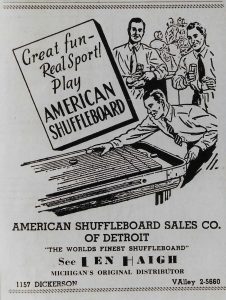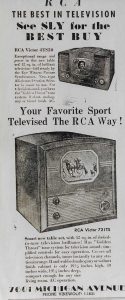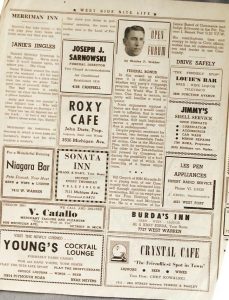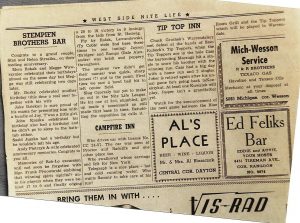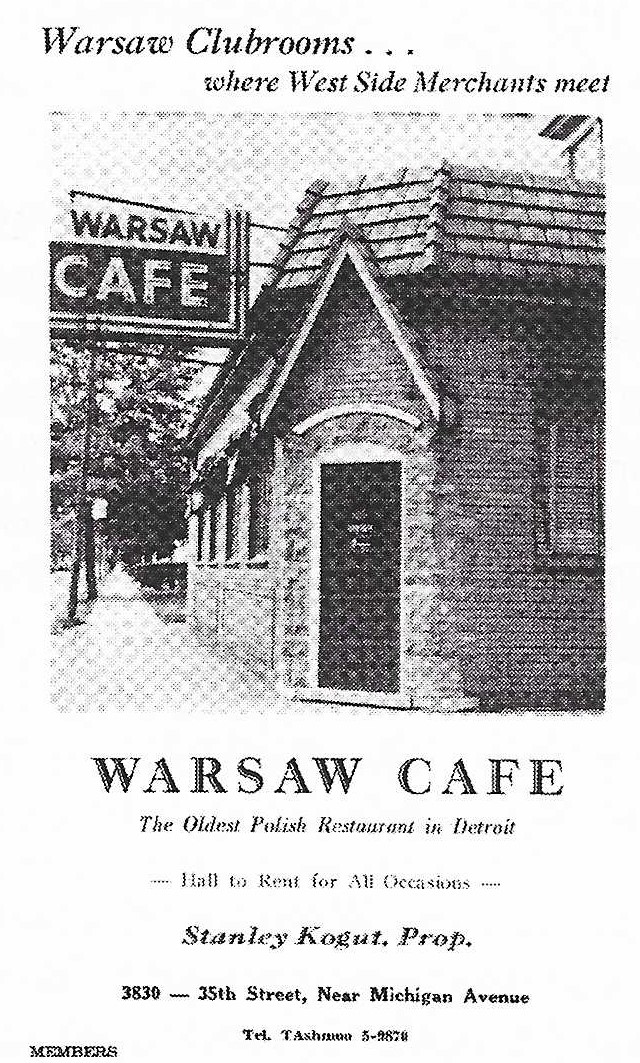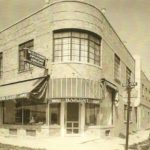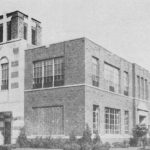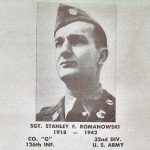A History of The West Side Courier
The West Side Courier was the voice of west side Polonia beginning in approximately 1930 and lasting throughout the 1960s or ‘70s. In the 1950s, the newspaper was located at 5757 Michigan Avenue between Campbell and Greusel. The phone number was LAfayette 3386. They had an alternate address of 6136 Michigan Avenue—possibly an earlier address—with a phone number of CEdar 1800.
The earliest known edition of the West Side Courier newspaper that exists is the December 19, 1930, edition, which is archived in the Burton Historical Collection of the Detroit Public Library. In 1930, the paper’s Editor-In-Chief was Harry H. Weinbaum. The Assistant Editor was Peter Whiffle. The Women’s Editor was Bertha B. Patrick. The Contributing Editor was Markus S. Simon. The Advertising Manager was Sol A. Poskel, and the Circulation Manager was George Gilette.
There were many other historic newspapers that served our west side Polonia, such as the West Detroit and Down River Times, the Warrendale Courier (which was an affiliate of the West Side Courier), the AFL-CIO News, the West Detroit Gazette, the Inter-City Post, and the sister papers, the Dearborn Press & Guide and the News Herald. There were, of course, the Polish papers as well, which had a broader circulation. They were published in Polish or Polish/English and began publishing in approximately 1900.
The Polish papers included the Polonia (Rekord) (Polonia Pub. Co., ca. 1900); the Tygodnik Polski (Polish Weekly; the Tygodnik Polski/Polish Weekly, Detroit; Polish and English, 1904); the Detroicki Dziennik Ludowy (ca. 1907; Polish Peoples Pub. Co., 1919; by 1923 it also included the Polish Peoples Daily; in Polish); the Rekord Codzienny (the Polish Daily Record; Polonia Pub. Co., ca. 1913; its weekly edition was titled Rekord Niedzeilny, or Polish Sunday Record); the Głos Ludowy (the People’s Voice; The People’s Voice, ca. 1924; daily until the 1930s; weekly until 1978; then monthly; Polish and English); the Robotnik Polski (Polish Socialist Alliance, Polish Workmen’s Aid Fund, and Polish American Labor Council, Chicago, 1906; Detroit, 1926; New York, 1934); the Polish Daily News (Dziennik Polski; English edition; Polish Daily News, ca. 1970; ceased publication in 1989); and the Polish Times/Czas Polski (Polish Times/Czas Polski, Sterling Heights; Polish and English, 2007).
However, for those growing up and living in Detroit’s west side Polonia throughout the 1930s, ‘40s, ‘50s, and ‘60s, the West Side Courier was a community mainstay. Many neighborhood boys got their first job at the newspaper, working door-to-door delivery. The newspaper sponsored the West Side Courier All Star Basketball Team in the 1940s and baseball programs at Dingeman Field, adjacent to Chadsey High School, in the 1960s.
A now-deceased Honorary Member of the Society was highly involved in sports throughout his life, and he had first-hand knowledge of the baseball program at Dingeman Field at McGraw and Cecil Streets. During an interview, he shared his memories of sports—especially baseball—and the West Side Courier. In the 1950s, he coached basketball for the Catholic Youth Organization (“CYO”) at St. Hedwig, and from 1967 to 1968, he coached the same program at St. Andrew. From 1967 through 1970, he ran the West Side Courier-sponsored baseball program at Dingeman Field. He recalled a time when a reporter and a photographer from the West Side Courier showed up at Dingeman Field to cover a story on the program and its players. He remembered the photographer taking pictures of the children as they played baseball.
Parish sports teams were very popular in the 1950s and 1960s as enrollment in area parishes and parochial schools grew and sports became an even more prevalent activity. Our Lady Queen of Angels had a baseball team, which eventually joined the Dingeman Field baseball program. At that time, there were approximately 160 children participating in the program.
According to one local blog spot, most of the west side Detroit bars sponsored softball teams back then. Some of the names were West Detroiter, the PRCU league, and the West Side Courier league. The paper also sponsored bowling teams, and it published league and team highlights and standings. The latest news on local bowling leagues was also printed.
One of the popular features of the West Side Courier was its “Nite Life” section, which covered advertising of events occurring at restaurants, bars, and other local entertainment venues. This section of the paper was extremely popular and consisted of numerous pages. Local bars, especially, advertised in this section.
In the “Nite Life” section, polka bands that played in the area’s bars were promoted. The editor inserted personal messages and observations, such as his opinion of the gołąbki being served at a particular restaurant.
The paper knit together businesses and people of the community in ways that could not be duplicated. A Society director recalled that when he was a child, his mother sent him to the store to pick up a copy of the paper as soon as it came out. During the 1960s, the West Side Courier was published every other Wednesday. At that time, Telway Hamburgers used to publish discount coupons in the paper for 5 cents off or for five burgers for a dollar, and his mother waited anxiously for those coupons.
If there was big news in the community, the West Side Courier printed it. That same Society director recalled a feature story that the West Side Courier published when he was approximately 10 years old. He and three of his siblings all were admitted to Zieger Hospital to have their tonsils removed by Dr. Sitner and Dr. Uzansky. The story appeared under the headline, “Four Children in the Same Family Had Their Tonsils Out at the Same Time.”
A long-time resident of the area recalled being singled out by a West Side Courier photographer to have her picture taken for the paper’s front page as she was entering the first grade at Logan Elementary School. On the first day of school, as she was walking into the school building, the photographer asked her to pose at the front door of the school while he took her picture for the paper. She remembered being dressed in a gray and yellow patterned coat.
Readers and the local public could place ads in the West Side Courier. During an interview, another now-deceased Honorary Member recalled a time when he was starting out as a west side Detroit accordionist. He and his drummer were beginning to get gigs, but they needed a saxophone player—and they needed someone who could drive, as neither one of them had a car or even a driver’s license. So they placed an ad in the West Side Courier for a saxophone player, with the caveat: MUST DRIVE. The ad elicited a call from a sax player studying music at then Wayne University, and they began to get a lot of wedding gigs.
The accordionist was born in 1934 and began performing when he was 15. In part because of that single newspaper ad, he went on to enjoy a sideline career of nearly 50 years as an orchestra leader while working full time and raising eight children. One of his largest clients was Roma Hall.
The Warrendale Courier, published by the West Side Courier & Associated Newspapers, published its first edition on May 23, 1946. It was also known as the Parkland Courier. It is unknown when it folded. But it is the West Side Courier that stands out in memory for most west side Detroit Polish Americans.
The West Side Courier was honored, along with the Tygodnik Polski (the Polish Weekly) and Czas Polski (the Polish Times), at the Society’s Tenth Annual Opłatek and Grand Gala Heritage Room Exhibit at St. Colette Catholic Church on December 27, 2015. Framed certificates of appreciation were presented to representatives of each newspaper. The certificate for the West Side Courier was accepted by Society directors and resides in the Society’s Heritage Room.
Sources:
https://chroniclingamerica.loc.gov/lccn/sn98066189/
Lawrence A. Choraszewski. Informal telephone conversations. (West Bloomfield, MI: May 4, 2020, and May 12, 2000)
Walt Cieslik. Informal telephone conversation. (West Bloomfield, MI: August 17, 2020)
Evelyn R. (Gomulka) DeLabbio. Informal telephone conversation. (West Bloomfield, MI: August 16, 2020)
Richard A. Kuzdak. Interview transcript. (Novi, MI: February 18, 2008)
Anthony C. Pakula. Interview transcript. (Livonia, MI: September 26, 2014)
Photos:
1) The West Side Courier headquarters building, ca. 1950. At the time, the paper was located at 5757 Michigan Avenue. The sign on the side of the building reads: “The West Side Courier: West Detroit’s Own Weekly Newspaper.” Photo source: Burton Historical Collection, Detroit Public Library; https://digitalcollections.detroitpubliclibrary.org/islandora/object/islandora%3A239755
2) Ad from the West Side Courier “Nite Life” section, June 25, 1948, featuring the West Side Dom Polski and “Television.” Collection of Evelyn (Gomulka) DeLabbio. Photo: Laurie A. Gomulka
3) West Side Courier ad for Michael Wozniak, grocer, at 7130 Michigan Avenue, “2 Doors East of Woolworth’s,” ca. 1940. Courtesy of Pat Ibbotson
4) Ad from the West Side Courier “Nite Life” section, advertising Polish-American dancing every Friday, Saturday, and Sunday at the Club Polonez, June 25, 1948. Tom Gomulka, accordion; Ted Lach, clarinet; John Kobylarz, drums (far left); unknown, back middle. This section focused on the area’s theaters, restaurants, clubs, parties, dances, and night life and entertainment in general. Collection of Evelyn (Gomulka) DeLabbio. Photo: Laurie A. Gomulka
5) West Side Courier’s Christmas edition front page, December 19, 1947 (VOL. 2, Number 51), featuring “Nite Life” announcements for Stanley Adamus (“the Polka King”) and His Men of Rhythm at the Polka Inn and the Johnny Kay Orchestra at the Tip-Top Inn. Top photo: Stan Adamus, clarinet, second from left; Staś Wiśniach, accordion, second from right. At the time, the paper had a phone number of CEdar 1800 and sold for 3 cents a copy. Collection of Greg Adamus. Photo: Laurie A. Gomulka
6) Photo from the West Side Courier’s Christmas edition front page, December 19, 1947 (VOL. 2, Number 51), with Stanley Adamus and His Men of Rhythm at the Polka Inn. Stan Adamus, clarinet, second from left; Staś Wiśniach, accordion. Collection of Laurie A. Gomulka, courtesy of Staś Wiśniach
7) Page from the West Side Courier “Nite Life” section, June 25, 1948. Collection of Evelyn (Gomulka) DeLabbio. Photo: Laurie A. Gomulka
8) Page from the West Side Courier “Nite Life” section, June 25, 1948. Collection of Evelyn (Gomulka) DeLabbio. Photo: Laurie A. Gomulka
9) American Shuffleboard Sales Co. ad from the West Side Courier “Nite Life” section, June 25, 1948. Collection of Evelyn (Gomulka) DeLabbio. Photo: Laurie A. Gomulka
10) RCA Victor ad from the West Side Courier “Nite Life” section, June 25, 1948. Collection of Evelyn (Gomulka) DeLabbio. Photo: Laurie A. Gomulka
11) Page from the West Side Courier “Nite Life” section, June 25, 1948. Collection of Evelyn (Gomulka) DeLabbio. Photo: Laurie A. Gomulka
12) Ad clipping from the West Side Courier “Nite Life” section, June 25, 1948. Collection of Evelyn (Gomulka) DeLabbio. Photo: Laurie A. Gomulka
